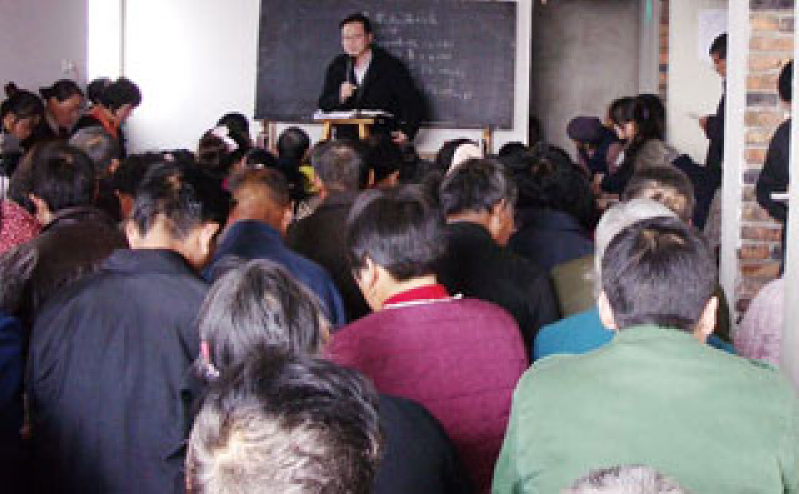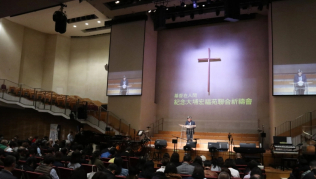
A New York-based Chinese Pastor has recently returned to United States from a short-term mission tour to China together with his co-workers. Upon his return, he shared with The Gospel Herald his insights on the co-existing opportunities and challenges facing the developing church of China and her theological education.
Rev. John Edward Hao, senior pastor of New York Faith Bible Association and president of Faith Bible Seminary, have accumulated a wealth of experiences from ministering and developing theological educations in New York for many years.
In the last decade, he has visited China for raising theological education in the house churches, ranging from those in the major cities along the eastern sea coast to those in the rural remote farm land further inland, where he gathered much first-hand accounts of the their opportunities and challenges.
Hao wishes to share these carefully organized insights with the overseas Chinese churches, hoping to relay across a comprehensive and objective account of the China’s house churches’ developments.
In the most recent visitation, Hao and his entourage visited seven regions throughout northern and southern China, traveling to traditional village area house churches, newly emerged city house churches, and the migrant churches. They’ve also visited the government-sanctioned Three-Self Patriotic Movement/China Christian Council (TSPM/CCC) churches and seminaries. Each of these meeting was marked with cordial exchanges and sharing.
From his observation, Hao said that the current situation in the churches in each area falls under one category, and by combining their situations together a micro-view of the church of China’s opportunities and challenges would be shown.
First Stop: House Church in Northern China
Development: Church Revival, Increase in Congregation Number
Challenges: Lack of Systematic Theological Training, Narrow-minded
After getting off a crowded train, Hao traveled to a remote small county village in northern China, where he was given the responsibility to preach at an annual gathering of around 200 house churches’ staff and leaders.
Besides delivering Bible-study messages, Hao also engaged in a dialogue and exchange with the Chinese house church ministers. From the conversations, he discovered that most of them are responsible for leading tens of gatherings, where each would have co-workers that oversee. One of the ministers leads 70 gathering points, where each point would have its own minister, but for various kinds of reasons, he was the only one able to participate in this annual ministerial Bible-Study conference. Looking at this, house churches in China need minister’s training and equipping urgently.
Hao said that he was greatly touched after seeing the passion of these amiable co-workers in Christ in their service for the Lord. Something that left him with a deep impression was a minister who started preaching behind the pulpit at age 15. When this minister first became committed to consecrate himself to service, a pastor intentionally gave him a relatively expensive Bible, which he held onto it preciously.
In that generation, house churches do not have any devotional or Bible-study books, so the minister’s only reference book is the Bible. The minister who started preaching at 15 has taught his congregation without any theological training, but by relying on the revelations that he received through reading the Bible.
From his experience of past decade of service in China, the seminary president expressed that many of the house churches’ ministers fall under similar situation, where they generally and widely lack systematic theological trainings. In some cases, the staff worker have never come across with theology, but relied on the revelation through reading God’s word. Seeing this, Hao delivered the messages in themes, and the listeners paid close attention while jotting down notes diligently. Their attitude of learning greatly touched him.
On the other hand, the local house churches are overly closed that they have never connected with outside world. This type of house churches have a very strong sense self-preservation, he explained, because they have received many attacks from cults, which caused their members to fall away, so they usually shut the church doors tightly and won’t recklessly invite any speakers from outside.
From the perspective of countering cults, the self-isolation of the house churches has a positive effect, but, at the same time, causes some side-effects. Because of the lack of exchange with outside, the house churches lack understandings toward the theology of other orthodox denominations, causing a narrow-minded denominational mindset and theological viewpoints – opposing other denominations and theological perspective and may even view them as cults. Hao worries that if this situation doesn’t change, it will serious damage the unity among the house churches in various regions.
Second Stop: Government-Sanctioned TSPM Church in Southern China
Development: Established Church Model, Excellent Facilities
Challenge: Shallow Faith in Members, Bottle-Neck in Church Growth
Concluding his services towards the house church leaders in northern China, Hao boarded the plane and flew southward, where he and his staff workers met and together visited the TSPM churches. The church is ministered by a female pastor and two ministers. As he and his staffs arrived, the church was holding a worship night, where around 200 people gathered in the chapel.
Through the one and half hour long praise and worship, the believers mostly sang praises, but the worship leaders didn’t lead the congregation in deep prayers, he observed. Besides the Sunday services held every weekend, the only other gathering is this music worship night, which he worries that the believers cannot be rooted deeply in faith just by these two events.
Another phenomenon that Hao discovered in his conversation with that church’s pastoral workers is that as large number of locals are moving outward the number of church attendants are declining, but with the pastoral staff’s lack of knowledge in church growth and in developing ministries, the ministers are often time helpless as the church faces a bottle-neck situation.
Meanwhile, this church’s situation isn’t the worse, shared Hao. The local church pastor also told him that the TSPM church in another region also have alarming health signs, where in a relatively large chapel the number of attendants have become scarcely few – these are all worth reflecting on.
Local TSPM pastoral workers attributed the cause of the decrease in number of church attendants to the large-scale migration of locals to other areas, but Hao thought that this explanation is overly biased. From what he knows, as large number of locals is moving out, large number of outside migrant workers are also pouring in. He believes that the question of how to lead these migrant workers to the church would be the new opportunity for these local TSPM churches.
If that TSPM church wants to experience a spiritual revival, then the pastoral workers should first become equipped with the knowledge of church growth and church planting, said Hao, and they should know how to develop different kinds of church ministries and focus on nourishing the believers’ foundation of faith, raising their spiritual lives.
To be Cont'd....
[Editor's note: Luke Leung translated the report.]







